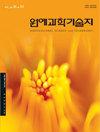不同发育阶段早、晚成熟授粉恒定不涩柿果实性状及基因表达分析
IF 0.8
4区 农林科学
Q3 HORTICULTURE
Korean Journal of Horticultural Science & Technology
Pub Date : 2021-06-01
DOI:10.7235/HORT.20210035
引用次数: 0
摘要
我们分析了授粉不涩柿子(Diospyros kaki Thunb.)晚熟品种“扶余”和早熟品种“苏树”在不同发育阶段的主要果实性状和转录组。每3周测量一次糖浓度和果皮颜色,直到‘Soshu’开花后18周(WAB)和‘Fuyu’开花后24周。对于果实中的糖浓度,“苏树”的蔗糖水平早于9周开始下降。“苏树”果皮着色进展较快,品种间的颜色差异在18WAB时最为显著。从9-18 WAB开始,每3周对果肉进行一次转录组分析。转录组的基因本体论术语分析表明,参与细胞和细胞器代谢和生长的催化和转运基因主要表达,而在KOG和KEGG分析中,大多数表达的基因与信号转导、核结构以及淀粉和蔗糖代谢有关。从两组样品中分析差异表达的基因:组I,其中在12、15和18WAB处取样的水果作为处理组与在9WAB处收集的样品作为每个品种的对照进行比较;和第二组,其中在每个WAB将“Soshu”果实样品作为处理组与“Fuyu”作为对照进行比较。对于包含三个比较组合的集合I的DEG,处理样本中上调基因的数量在“扶余”的18WAB和“苏蜀”的15WAB处最高。对于集合II的DEG,在12WAB和15WAB时,“Soshu”的下调基因数量和上调基因数量分别高于“Fuyu”。然后,我们将果实性状相关基因的表达模式与性状的表型变化进行了比较。我们的研究结果表明,参与碳水化合物代谢的UGPase-1和AGPase-1,以及参与类胡萝卜素生物合成的CRTISO和PDS,可能会诱导“苏树”果实早熟。此外本文章由计算机程序翻译,如有差异,请以英文原文为准。
Traits and Gene Expression Analysis of Early and Late Ripening Pollination Constant Non-Astringent Persimmon Fruits at Different Developmental Phases
We analyzed the major fruit traits and transcriptomes between a late-ripening cultivar ‘Fuyu’ and an early-ripening cultivar ‘Soshu’ of pollination constant non-astringent persimmon (Diospyros kaki Thunb.) at different developmental stages. Sugar concentration and fruit peel color were measured every 3 weeks, until 18 weeks after full bloom (WAB) for ‘Soshu’ and 24 WAB for ‘Fuyu’. For the sugar concentration in fruit, sucrose levels began to decline 9 weeks earlier in ‘Soshu’. Fruit peel coloring progressed faster in ‘Soshu’, and differences in color between the cultivars were most notable at 18 WAB. Transcriptome analysis was carried out for fruit flesh every 3 weeks from 9-18 WAB. Gene ontology term analysis of the transcriptome indicated that catalytic and transport genes involved in metabolism and growth in cells and cellular organelles were mainly expressed, while in KOG and KEGG analysis, the majority of expressed genes were related to signal transduction, nuclear structure, and starch and sucrose metabolism. Differentially expressed genes were analyzed from two sets of samples: set I, in which fruits sampled at 12, 15, and 18 WAB were compared as the treatment group to the sample collected at 9 WAB as the control for each cultivar; and set II, in which fruit samples of ‘Soshu’ were compared as the treatment group to ‘Fuyu’ as the control at each WAB. For the DEGs of set I, containing three comparison combinations, the number of up-regulated genes in the treatment sample was highest at 18 WAB in ‘Fuyu’ and at 15 WAB in ‘Soshu’. For the DEGs of set II, the number of down-regulated genes and the number of up-regulated genes were higher in ‘Soshu’ compared to ‘Fuyu’ at 12 WAB and 15 WAB, respectively. We then compared the expression patterns of fruit trait-related genes with the phenotypic changes in traits. Our results indicated that UGPase-1 and AGPase-1, involved in carbohydrate metabolism, and CRTISO and PDS, involved in carotenoid biosynthesis, may induce early fruit ripening in ‘Soshu’. In addition,
求助全文
通过发布文献求助,成功后即可免费获取论文全文。
去求助
来源期刊
CiteScore
2.00
自引率
0.00%
发文量
0
审稿时长
1 months
期刊介绍:
Horticultural Science and Technology (abbr. Hortic. Sci. Technol., herein ‘HST’; ISSN, 1226-8763), one of the two official journals of the Korean Society for Horticultural Science (KSHS), was launched in 1998 to provides scientific and professional publication on technology and sciences of horticultural area. As an international journal, HST is published in English and Korean, bimonthly on the last day of even number months, and indexed in ‘SCIE’, ‘SCOPUS’ and ‘CABI’. The HST is devoted for the publication of technical and academic papers and review articles on such arears as cultivation physiology, protected horticulture, postharvest technology, genetics and breeding, tissue culture and biotechnology, and other related to vegetables, fruit, ornamental, and herbal plants.

 求助内容:
求助内容: 应助结果提醒方式:
应助结果提醒方式:


